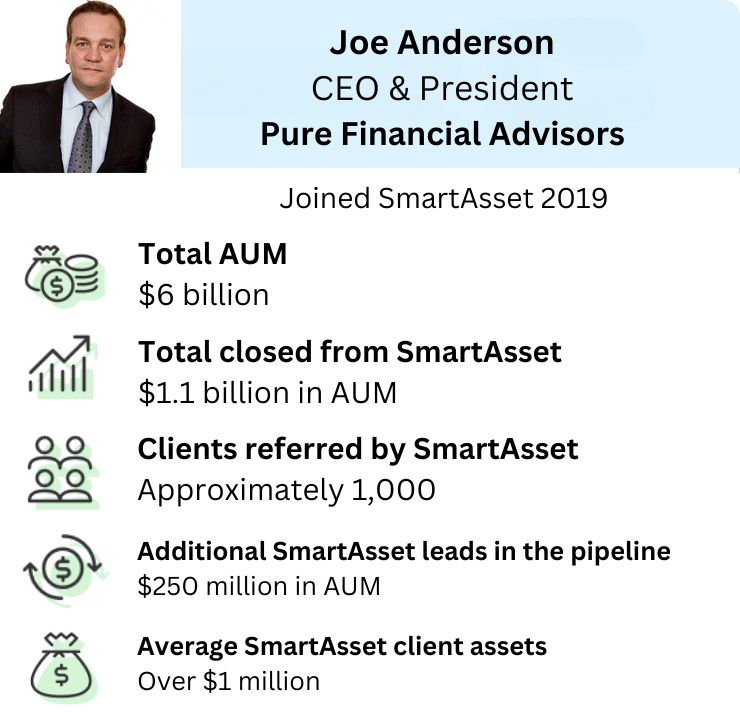 discussing different financial planning stages for a family." width="400" height="200" />
discussing different financial planning stages for a family." width="400" height="200" /> discussing different financial planning stages for a family." width="400" height="200" />
discussing different financial planning stages for a family." width="400" height="200" />
Life cycle financial planning is a multi-stage approach to helping your clients build and manage wealth. As clients age and experience life changes, their financial goals and needs may evolve, which in turn can affect the type of advice you offer. Understanding the financial planning life cycle can help you prepare for each new phase in your client’s journey.
Ready to grow your client base? SmartAdvisor connects you with leads.
Life cycle financial planning is just what it sounds like—an approach to financial planning that encompasses a client’s different life stages. The decisions people make with their money can look quite different at 52 vs. 22 and a life cycle strategy is meant to account for that.
Why would it benefit an advisor to think about financial planning in life cycles? The short answer is that it can help you to better understand what your clients may need at a particular moment in time. Different life stages can present different struggles or challenges that require unique solutions.
Breaking a client’s financial plan up into ‘snapshots’ of time also makes it easier to look ahead, while giving you room to pivot the advice you’re offering should a major life change occur. For example, you might have a client in their mid-40s who thinks they have their financial plan finally figured out only to be delivered a curveball in the form of a divorce.
You may need to make major changes to their plan to keep them on track with their goals. Looking at the broader life cycle picture can help you decide what to adjust. You can then convey those changes to your client in a way that helps to ease their fears about the future if the divorce has them in a panic.
 discussing different financial planning stages for a family." width="724" height="483" />
discussing different financial planning stages for a family." width="724" height="483" />
The financial planning life cycle can be divided into five stages, starting with young adulthood and ending in retirement. Here’s how each stage works for financial planning.
Early adulthood can encompass the teenage years through college, and this is when most people begin to have their first experiences with managing money. Your target client base may not be 20-somethings but it’s helpful to understand the kinds of issues this age group faces, as they may continue to carry some of those issues into later life stages.
For example, a 25-year-old who’s graduating with $100,000 in student loan debt may come to you 10 years from now in need of a plan for how to pay off the last of it so they can buy a home. Or they may have neglected saving for retirement up to this point and need a plan for getting caught up.
If your client base includes young adults, you may be starting with the basics to help them build a financial plan. That can mean helping them to develop a budget and a plan for saving, as well as a plan for paying off education debt. You can also introduce them to investing, though they may not have a lot of disposable income to invest just yet.
The second stage of the financial planning life cycle typically centers on adults moving into their 30s who are preparing to get married and/or have children. At this stage of life, financial needs may shift away from debt repayment and towards saving and investing. College planning may also be of concern to clients who have young kids now but don’t want to be caught off-guard by high tuition costs 15 years down the road.
Clients in this life stage may not have reached their peak earnings years yet but they might be interested in making the most of the income they do have. They may be primed to expand their investing efforts beyond their 401(k) and explore taxable retirement accounts or the possibilities that real estate may hold.
They may also need advice on how to protect the assets they’ve acquired so far. This is a suitable time to discuss life insurance planning and what kind of policy might best fit their needs.
This stage is when clients may be hitting their early 40s and seeing their earnings climb. Ideally, clients have paid off their consumer debt excluding their mortgage and are focused on saving and investing to build wealth. But that isn’t always the case, of course, and you may be working with clients who are behind on saving for retirement or have yet to get started.
The good news is that if they’re in their peak earning years, they may have more financial resources to commit to reaching their goals. At the same time, they may be wondering where college planning is going to fit into the picture if their kids are approaching college age.
Your job during this stage is to help them prioritize what’s most important and identify the potential gaps in their plan that might leave them with a shortfall. For example, if they’re contributing to a 401(k) but are still off the target for their retirement savings goal, then you might need to tweak their plan to either increase their contribution rate or add in an individual retirement account (IRA).
If they’re considering taking out student loans for their children, that’s an important discussion to have. Making payments to federal or private student loans for another decade or more could significantly impact their ability to save and invest.
The pre-retirement countdown usually begins in the early 50s though it may come even sooner for people who are hoping to retire well before 65. At this stage of life, your clients may need advice on things like choosing the right retirement age, deciding when to take Social Security benefits and planning for long-term care needs.
Clients may be maxing out their workplace retirement plans or IRAs or wondering when they can begin taking distributions from those accounts without a tax penalty. They may be eyeing their investment portfolios and asking themselves if it makes sense to shift into a more conservative asset allocation.
This is also the time when they might be considering purchasing a long-term care policy or an annuity to provide a guaranteed stream of income in retirement. They may look to you to help them assess their needs and find the right products to fill them.
Retirement for most people usually happens in their 60s, though you might have clients who plan to retire later or earlier. By this stage, most of the work of building wealth has likely been done so now the focus is on preserving it and/or passing it on.
For instance, clients may be wondering how to draw down taxable and tax-advantaged assets to ensure they last while minimizing what they pay in taxes. Clients may also be concerned with estate planning and how to pass on assets to their loved ones in the most tax-efficient way possible. They may need to update their wills (or draft one if they haven’t yet) and set up one or more trusts.
And you might have clients who are dealing with an entirely different situation. For instance, you may work with a couple who’s planning to retire on a cruise ship or an individual who retires, and then decides they’d like to start a business or set up a private foundation. Keeping the lines of communication open can ensure that whatever they decide, you’re prepared to help them execute their plan.

Getting to know the financial planning life cycle benefits both you and your clients if you’re offering them the right advice, at the right time. If you’re able to serve clients well in the earlier life cycle stages, they may be more inclined to remain your clients as they move into later life phases.
Photo credit: ©iStock.com/kate_sept2004, ©iStock.com/Ridofranz, ©iStock.com/kate_sept2004
Rebecca Lake, CEPF®Rebecca Lake is a retirement, investing and estate planning expert who has been writing about personal finance for a decade. Her expertise in the finance niche also extends to home buying, credit cards, banking and small business. She's worked directly with several major financial and insurance brands, including Citibank, Discover and AIG and her writing has appeared online at U.S. News and World Report, CreditCards.com and Investopedia. Rebecca is a graduate of the University of South Carolina and she also attended Charleston Southern University as a graduate student. Originally from central Virginia, she now lives on the North Carolina coast along with her two children. Rebecca also holds the Certified Educator in Personal Finance (CEPF®) designation.
Read More About Advisor Resources



More from SmartAsset
SmartAsset Advisors, LLC ("SmartAsset"), a wholly owned subsidiary of Financial Insight Technology, is registered with the U.S. Securities and Exchange Commission as an investment adviser. SmartAsset's services are limited to referring users to third party advisers registered or chartered as fiduciaries ("Adviser(s)") with a regulatory body in the United States that have elected to participate in our matching platform based on information gathered from users through our online questionnaire. SmartAsset receives compensation from Advisers for our services. SmartAsset does not review the ongoing performance of any Adviser, participate in the management of any user's account by an Adviser or provide advice regarding specific investments.
We do not manage client funds or hold custody of assets, we help users connect with relevant financial advisors.
This is not an offer to buy or sell any security or interest. All investing involves risk, including loss of principal. Working with an adviser may come with potential downsides such as payment of fees (which will reduce returns). There are no guarantees that working with an adviser will yield positive returns. The existence of a fiduciary duty does not prevent the rise of potential conflicts of interest.